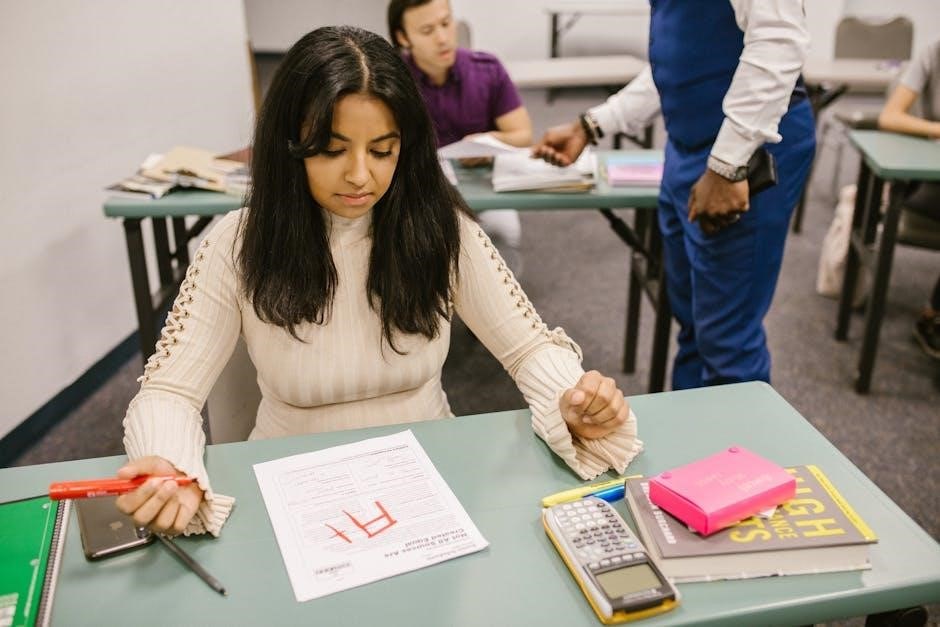MAP Test Practice for 1st Grade: Overview
Preparing your first grader for the MAP test? This overview provides helpful tips, free sample questions, and a complete understanding of the test’s format and scoring for success.

Understanding the MAP Test
The MAP test measures student growth in reading, math, language usage, and science. It adapts to your child’s level, providing personalized insights for educators and parents alike.
What is the NWEA MAP Test?
The NWEA MAP (Measures of Academic Progress) test is a computerized adaptive assessment. It’s designed to measure a student’s academic growth over time, providing valuable insights into their learning progress. Unlike traditional fixed-form tests, the MAP test adjusts its difficulty based on the student’s responses. If a student answers a question correctly, the next question will be more challenging. Conversely, if a student answers incorrectly, the subsequent question will be easier.
This adaptive nature allows the test to pinpoint a student’s specific skill level and identify areas where they may need additional support. For first graders, the MAP test typically covers reading and mathematics, assessing foundational skills essential for future academic success. The results of the MAP test are often used by teachers and schools to inform instruction and tailor learning experiences to meet individual student needs. Ultimately, the NWEA MAP test serves as a tool to support student growth and achievement throughout their academic journey.
Subjects Covered in 1st Grade MAP Testing
In first grade, the NWEA MAP test primarily focuses on two core subjects: reading and mathematics. The reading portion assesses foundational literacy skills, including phonological awareness, phonics, vocabulary, and reading comprehension. Students may be asked to identify letter sounds, decode words, and understand the meaning of simple sentences and passages.
The mathematics section evaluates a student’s understanding of basic math concepts, such as number sense, counting, addition, subtraction, and geometry. Questions may involve identifying numbers, solving simple math problems, and recognizing shapes. In some instances, the NWEA MAP test may also include a science assessment for first graders, but reading and math are the primary focus. The specific content covered in each subject area may vary slightly depending on the version of the test being administered. However, the overall goal is to assess a student’s mastery of essential first-grade skills in reading and math.
Free Resources for MAP Test Practice
Looking for free MAP test practice for your 1st grader? Find sample questions and PDF practice tests to help them prepare confidently and effectively.
Where to Find Free Sample Questions
Preparing your child for the 1st Grade MAP test doesn’t have to break the bank! Several resources offer free sample questions to give you a glimpse of the test’s format and content. Start by exploring educational websites designed for elementary school students. Many of these sites offer free practice questions aligned with the NWEA MAP test standards, covering math and reading.
Teachers Pay Teachers is another valuable resource. Many educators share free sample question sets and mini-quizzes related to the MAP test for various grade levels, including 1st grade. Look for resources that align with the RIT bands your child is expected to perform within.
Don’t forget to check with your child’s school or teacher. They may provide access to online practice platforms or offer printable sample questions that can be used at home. Utilizing these free resources can provide a solid foundation for your child’s MAP test preparation without any cost.
Utilizing PDF Practice Tests
PDF practice tests can be incredibly valuable tools for preparing your 1st grader for the MAP test. These downloadable resources offer a convenient and structured way to simulate the testing environment at home. When utilizing PDF practice tests, start by creating a dedicated workspace free from distractions to mimic the actual test setting.
Print out the PDF and provide your child with pencils, erasers, and any other materials they might need during the test. Encourage them to work through the questions independently, offering support only when necessary. After completing the test, review the answers together, focusing on understanding the concepts behind each question.
PDF practice tests often come with answer keys, making it easy to identify areas where your child may need additional support. Consider using these tests to track progress over time, noting improvements in accuracy and speed. Remember that consistency is key, and regular practice with PDF tests can significantly boost your child’s confidence and performance on the MAP test.

Types of Questions on the 1st Grade MAP Test
The MAP test includes varied question types, assessing math and reading skills. Sample questions offer a glimpse into what first graders can expect on the test.
Reading Sample Questions
Reading sections of the MAP test assess foundational literacy skills. Sample questions evaluate comprehension, vocabulary, and basic reading proficiency.
Expect questions that require identifying main ideas, understanding character actions, and recognizing story elements. Students may need to match lowercase letters. Practice tests often include passages followed by multiple-choice questions designed to gauge understanding.
These sample questions are designed to mirror the types of questions found on the actual MAP test, offering a valuable opportunity to familiarize children with the format and content. Worksheets and free PDFs can be found. Ensure your child practices with varied reading materials to enhance comprehension and vocabulary. Regular practice builds confidence and improves performance on the MAP test. Get glimpse of the questions. This will help prepare for their NWEA MAP Test.
Math Sample Questions
Math sections in the MAP test assess basic numeracy and problem-solving skills. Sample questions evaluate number sense, basic operations, and geometric shapes. Students may be asked to identify cones or solve simple addition and subtraction problems.
Practice questions often involve patterns, functions, and algebra, though at an introductory level. Word problems are included to assess real-world application of math concepts. Sample questions will help children expect on the test. These will help your child get ready for the NWEA MAP Test. Free practice tests and worksheets are available to help prepare. Regular practice with these types of questions will build your child’s confidence and proficiency. Focus on understanding core concepts and applying them to different problem scenarios. Math problems may include simple map reading, counting houses, and traffic lights.
Preparing Your Child for the MAP Test
Equip your child for MAP test success with effective strategies. Utilize free practice questions, focus on core concepts, and encourage a confident approach for optimal results.
Tips and Strategies for Success
To maximize your child’s potential on the 1st Grade MAP test, implement these strategies. Begin with readily available free practice tests to familiarize them with the question formats. Focus on strengthening core skills in both reading and math, addressing any identified weaknesses. Utilize sample questions to simulate the actual testing environment, reducing anxiety and building confidence.
Encourage a growth mindset, emphasizing that the MAP test measures progress and helps identify areas for improvement, rather than solely focusing on achievement. Break down study sessions into manageable chunks to maintain engagement and prevent overwhelm.
Promote a positive attitude towards testing, framing it as an opportunity to showcase their learning. Ensure adequate rest and nutrition before the test day, fostering optimal cognitive function. Finally, celebrate effort and progress, reinforcing a love for learning beyond test scores. Effective preparation combines targeted practice with emotional support for confident test-taking.

MAP Test Scoring and Interpretation
Understanding MAP test results involves interpreting RIT scores and goal achievement. Utilize the MAP goal score translation chart to analyze performance and guide future learning strategies effectively;
Understanding RIT Scores
RIT, or Rasch Unit, scores are a fundamental aspect of the NWEA MAP test, indicating a student’s achievement level, regardless of their grade. These scores provide a continuous scale to measure growth over time, offering a more precise picture of learning progress than grade-level comparisons alone. A RIT score reflects what a student knows and is ready to learn, pinpointing specific areas of strength and areas needing improvement.
For first graders taking the MAP test, understanding RIT scores is crucial for parents and educators. These scores help track individual student growth from fall to spring, allowing for personalized instruction tailored to their specific learning needs. By analyzing RIT scores, teachers can identify students who may need additional support or enrichment, ensuring that all learners are challenged appropriately. Furthermore, RIT scores are used to predict future performance and inform instructional decisions, making them a valuable tool in guiding a student’s academic journey.
MAP Goal Score Translation Chart
The MAP Goal Score Translation Chart is an essential resource for interpreting a student’s performance on the NWEA MAP test. This chart provides a breakdown of RIT scores into different performance levels, typically categorized as Low (LO), Average (AV), and High (HI). These categories help educators and parents understand how a student is performing relative to established norms for their grade level.
For 1st grade MAP testing, the translation chart offers specific RIT score ranges for each performance level in subjects like mathematics and reading. For instance, a chart based on 2020 RIT norms might define a “Low” score as anything below a certain RIT value (e.g., 139), while “High” scores fall above another value (e.g., 180). The “Average” range would then encompass the scores in between. This detailed breakdown allows for targeted interventions and personalized learning strategies, ensuring each student receives the support they need to succeed. Accessing and understanding this chart is key to maximizing the value of MAP test results.

Additional Resources and Support
Explore our comprehensive collection of full practice tests and prep packages designed to provide your child with the best possible MAP test preparation experience.
Full Practice Tests and Prep Packages
To maximize your child’s potential on the NWEA MAP 1st Grade test, consider utilizing full-length practice tests and comprehensive prep packages. These resources offer a simulated testing environment, allowing children to become familiar with the test format, question types, and time constraints.
These packages often include a variety of practice questions that cover all subjects assessed on the MAP test, such as reading, math, and sometimes even science. Furthermore, they frequently provide detailed answer explanations, enabling parents and educators to identify areas where the child may need additional support.
Investing in full practice tests and prep packages can significantly boost your child’s confidence and reduce test anxiety. These resources are designed to align with the MAP test’s specific standards and RIT bands, ensuring targeted and effective preparation.
Look for packages that also offer progress tracking and personalized feedback to tailor your child’s study plan. With the right resources, your child can approach the MAP test with confidence and achieve their full potential.
